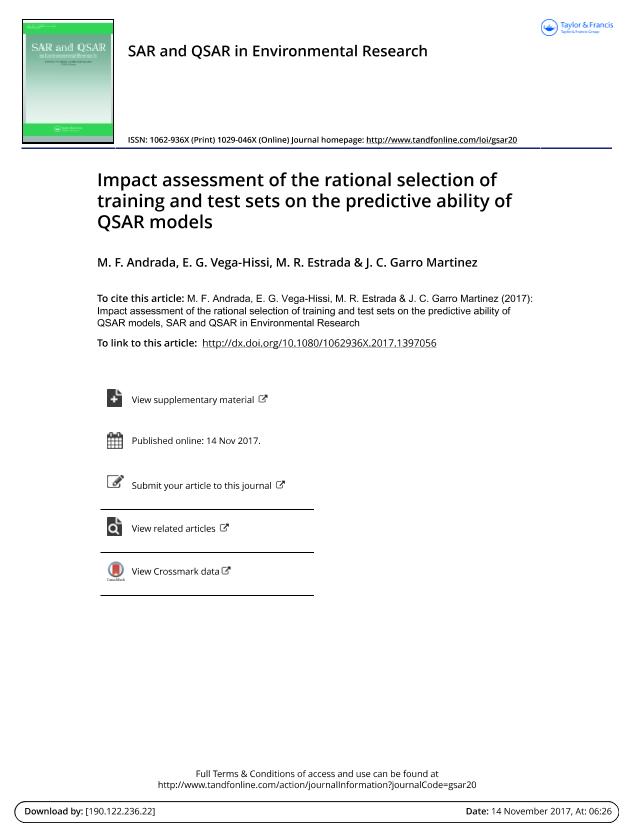Artículo
Impact assessment of the rational selection of training and test sets on the predictive ability of QSAR models
Andrada, Matias Fernando ; Vega Hissi, Esteban Gabriel
; Vega Hissi, Esteban Gabriel ; Estrada, Mario Rinaldo; Garro Martinez, Juan Ceferino
; Estrada, Mario Rinaldo; Garro Martinez, Juan Ceferino
 ; Vega Hissi, Esteban Gabriel
; Vega Hissi, Esteban Gabriel ; Estrada, Mario Rinaldo; Garro Martinez, Juan Ceferino
; Estrada, Mario Rinaldo; Garro Martinez, Juan Ceferino
Fecha de publicación:
12/2017
Editorial:
Taylor & Francis Ltd
Revista:
Sar And Qsar In Environmental Research
ISSN:
1062-936X
e-ISSN:
1029-046X
Idioma:
Inglés
Tipo de recurso:
Artículo publicado
Clasificación temática:
Resumen
This study performed an analysis of the influence of the training and test set rational selection on the quality and predictively of the quantitative structure–activity relationship (QSAR) model. The study was carried out on three different datasets of Influenza Neuraminidase (H1N1) inhibitors. The three datasets were divided into training and test sets using three rational selection methods: based on k-means, Kennard–Stone algorithm and Activity and the results were compared with Random selection. Then, a total of 31,490 mathematical models were developed and those models that presented a determination coefficient higher than: r2 train > 0.8, r2 loo > 0.7, r2 test > 0.5 and minimum standard deviation (SD) and minimum root-mean square error (RMS) were selected. The selected models were validated using the internal leave-one-out method and the predictive capacity was evaluated by the external test set. The results indicate that random selection could lead to erroneous results. In return, a rational selection allows for obtaining more reliable conclusions. The QSAR models with major predictive power were found using the k-means algorithm and selection by activity.
Archivos asociados
Licencia
Identificadores
Colecciones
Articulos(IMIBIO-SL)
Articulos de INST. MULTIDICIPLINARIO DE INV. BIO. DE SAN LUIS
Articulos de INST. MULTIDICIPLINARIO DE INV. BIO. DE SAN LUIS
Citación
Andrada, Matias Fernando; Vega Hissi, Esteban Gabriel; Estrada, Mario Rinaldo; Garro Martinez, Juan Ceferino; Impact assessment of the rational selection of training and test sets on the predictive ability of QSAR models; Taylor & Francis Ltd; Sar And Qsar In Environmental Research; 28; 12; 12-2017; 1011-1023
Compartir
Altmétricas



